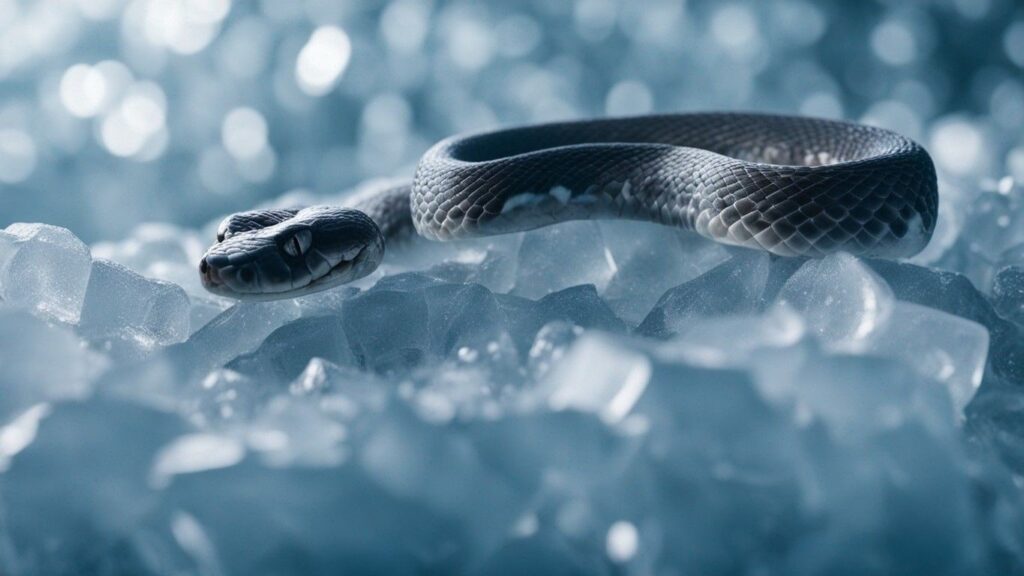So, picture this: a snake frozen solid in the icy winter landscape. You might think it’s game over for our slithery friend, right? Well, think again!
Snakes reportedly utilize a series of biological adaptations including antifreeze proteins and cryoprotectants to survive freezing temperatures without substantial damage. These mechanisms, which also involve controlled ice formation and reduced metabolism, not only facilitate their survival in cold periods but also hold promise for applications in medical tissue preservation and cryopreservation techniques.
In this fascinating article, we explore the incredible world of snakes and their ability to survive freezing temperatures.
From their mind-boggling biological adaptations to the mysterious process of resurrection, you’ll be amazed by the astonishing resilience of these cold-blooded creatures.
Get ready to have your mind blown as we uncover the truth behind the question: can snakes freeze and come back to life?
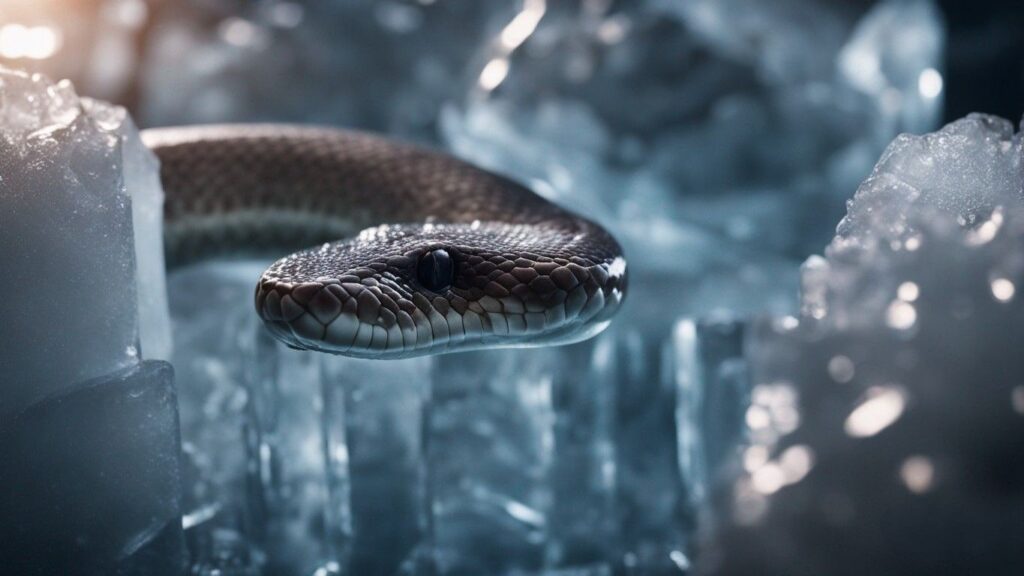
What happens when snakes freeze?
When snakes are exposed to freezing temperatures, they undergo a remarkable survival mechanism known as freezing tolerance.
Rather than suffering tissue damage or death like many other animals, snakes have developed adaptations that allow them to endure freezing conditions and then recover once temperatures rise.
Understanding how snakes survive freezing temperatures is not only fascinating but also provides valuable insights into the capabilities of cold-blooded animals.
How do snakes survive freezing temperatures?
Snakes have evolved unique strategies to survive freezing temperatures. They employ a combination of physiological and biochemical mechanisms that protect their cells and tissues from damage caused by freezing.
These adaptations enable snakes to supercool, initiate ice formation strategically, and employ cryoprotectants to survive extended periods of cold hibernation.
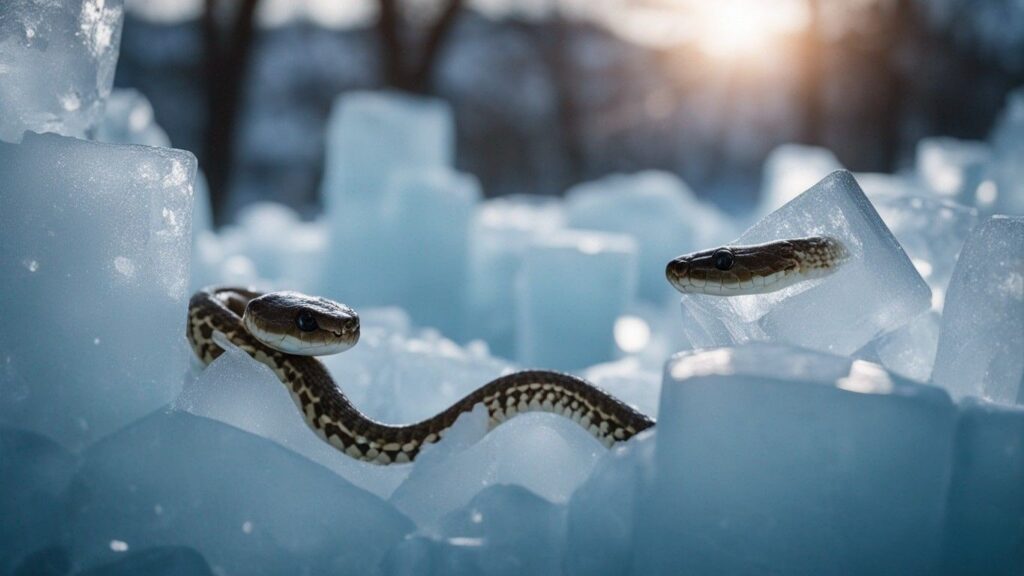
The process of snake freezing
Supercooling
One of the first steps in a snake’s freezing process is supercooling. Supercooling occurs when the snake’s body temperature drops below freezing without actually freezing.
Snakes are able to maintain their liquid state at these sub-zero temperatures due to the presence of antifreeze proteins, which prevent ice crystals from forming prematurely.
By supercooling, snakes can remain in a semi-frozen state without sustaining significant damage.
Initiation of ice formation
Once the snake’s body temperature reaches a critical threshold, ice formation is initiated.
This is a controlled process where ice crystals slowly form in specific locations, minimizing damage to vital organs and tissues.
By strategically guiding ice formation, snakes can prevent the formation of ice crystals in sensitive areas and ensure their survival while frozen.
Adaptations for survival
Antifreeze proteins
Antifreeze proteins play a crucial role in a snake’s ability to survive freezing temperatures.
These proteins bind to ice crystals and prevent them from growing larger, ultimately protecting the snake’s cells from damage.
Antifreeze proteins also lower the freezing point of the snake’s bodily fluids, allowing for supercooling and control over the freezing process.
This adaptation ensures that the snake can survive in extremely cold environments without suffering from tissue damage.
Cryoprotectants
Cryoprotectants are another important adaptation in snakes that aid in surviving freezing temperatures.
These compounds, such as glycerol and glucose, act as protectants against ice crystal formation and cellular damage.
By increasing the osmolarity of cells, cryoprotectants prevent water from freezing, thus preserving cell integrity.
This remarkable adaptation allows snakes to endure freezing conditions and resume normal bodily functions once temperatures rise.
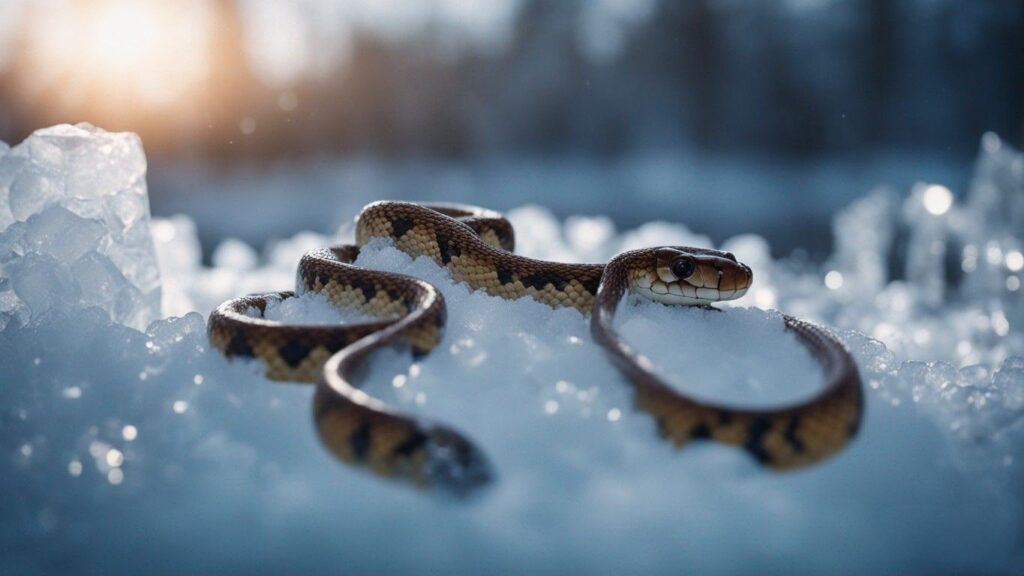
Snake species that can survive freezing
Several snake species have been found to exhibit freezing tolerance, allowing them to survive in even the harshest winter climates.
Garter snakes
Garter snakes (Thamnophis sirtalis) are well-known for their ability to survive freezing temperatures.
These snakes gather in large groups and hibernate together, creating a warmer microclimate that aids in their survival.
Garter snakes also produce antifreeze proteins and cryoprotectants, further enhancing their ability to endure freezing conditions.
Brown snakes
Brown snakes (Storeria dekayi) are another snake species that has been observed to survive freezing temperatures.
They are capable of supercooling and initiating controlled ice formation, allowing them to remain in a frozen state without incurring significant damage.
In addition, brown snakes have been found to produce high concentrations of cryoprotectants, further enhancing their survival in freezing conditions.
North American racer snakes
North American racer snakes (Coluber constrictor) have also shown freezing tolerance. These fast-moving snakes can withstand low temperatures and initiate ice formation in a controlled manner.
By utilizing antifreeze proteins and cryoprotectants, North American racer snakes can survive in freezing environments and recover when conditions improve.
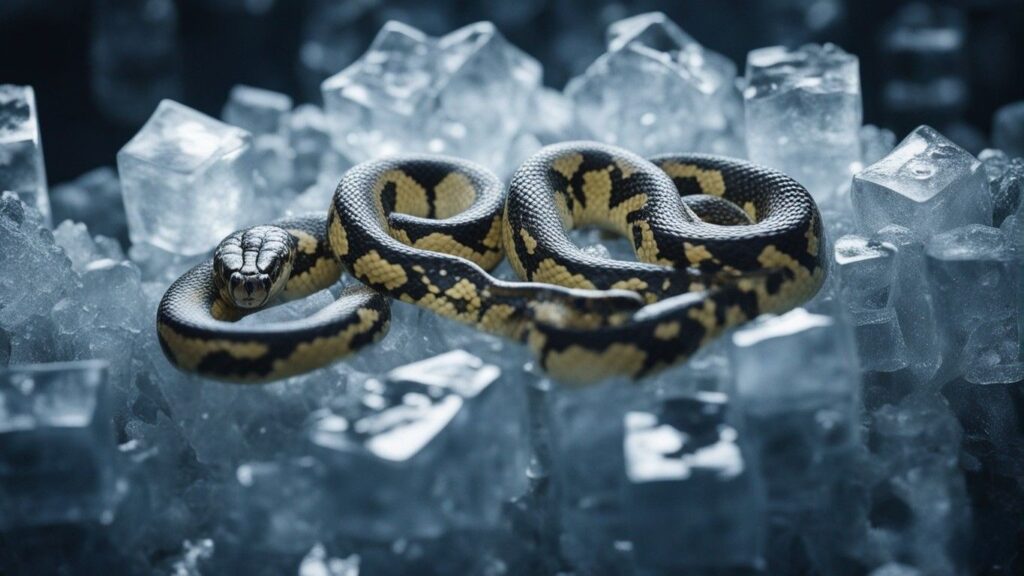
Effects on snake behavior
Freezing temperatures have notable effects on snake behavior, as the survival mechanisms employed by snakes during freezing can significantly impact their normal activities.
Decreased metabolic rate
As snakes freeze, their metabolic rate decreases dramatically. This reduction in metabolic activity allows snakes to conserve energy, as the demand for oxygen and nutrients decreases when the snake is in a frozen state.
By slowing down their metabolism, snakes minimize their resource utilization and are able to survive for extended periods without food or water.
Reduced locomotion
Snakes also exhibit reduced locomotion when exposed to freezing temperatures. The cold temperatures slow down nerve impulses, making it more challenging for snakes to move efficiently.
Additionally, the icy conditions and reduced muscle function make it difficult for snakes to navigate and capture prey.
As a result, snakes limit their movements and conserve energy until more favorable conditions arise.
Physiological changes during freezing
While frozen, snakes undergo several physiological changes that aid in their survival and protect their vital functions.
Heart rate and blood flow decrease
As snakes freeze, their heart rate and blood flow decrease significantly. This reduction in cardiac activity helps minimize the need for oxygen and nutrients while the snake is in a dormant state.
The slowed heart rate also reduces the risk of damage caused by restricted blood flow in the partially frozen snake.
Metabolic shutdown
Snakes entering a frozen state experience a metabolic shutdown. The body’s normal cellular functions slow down, conserving energy and reducing the demand for resources.
During this shutdown, the snake’s metabolism is primarily reserved for essential functions, such as maintaining cellular integrity and preventing excessive damage due to freezing.
Cellular dehydration
To survive freezing temperatures, snakes undergo cellular dehydration. As the snake’s body freezes, water is drawn out of the cells and into intercellular spaces.
This process prevents ice crystal formation within the cells, minimizing damage and ensuring the survival of vital cellular components.
Cellular dehydration is another crucial adaptation that enables snakes to thrive in freezing conditions.
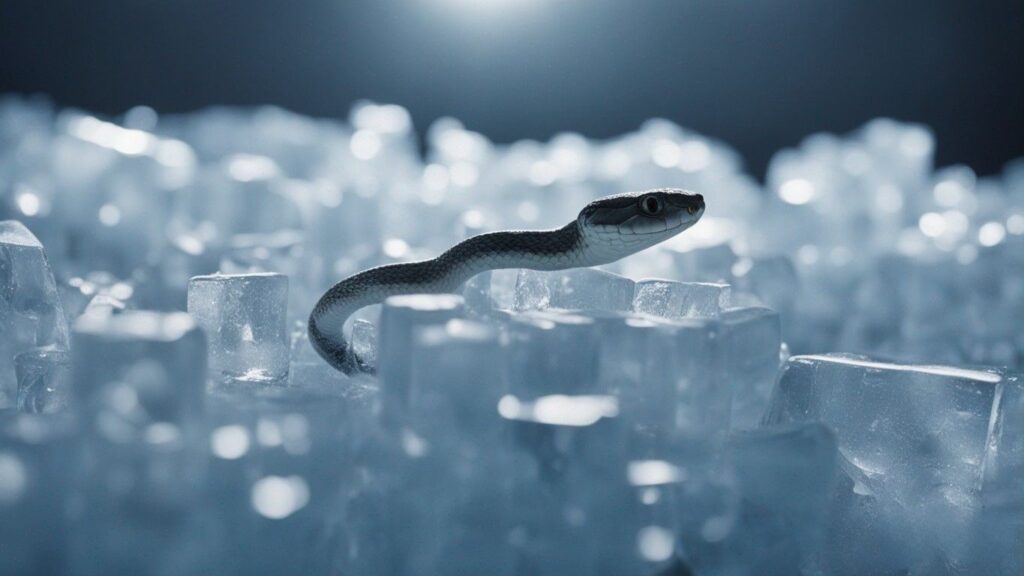
Thawing and recovery process
Once temperatures rise and conditions become more favorable, snakes begin the process of thawing and recovery.
This gradual warming allows the snake’s bodily functions to return to normal and resume essential activities.
Gradual warming
To prevent sudden physiological shocks, snakes gradually warm up as temperatures rise. This gradual warming allows for the recovery of cellular functions without subjecting the snake to unnecessary stress.
By slowly raising their body temperature, snakes can thaw without causing damage to their tissues and organs.
Revival of bodily functions
As the snake thaws, its bodily functions gradually return to normal. Heart rate increases, blood flow resumes, and cellular activity recommences.
The snake’s metabolic rate also rises, providing energy for essential functions, such as digestion and locomotion.
Through this revival process, the snake is able to recover fully and resume its normal activities.
Potential applications in medicine
The ability of snakes to survive freezing temperatures has captured the interest of researchers and scientists.
The study of their adaptations and mechanisms may hold potential applications in the field of medicine, particularly in the preservation of organs and tissues.
By understanding how snakes survive freezing, scientists can develop strategies to better preserve human tissues for transplantation and improve cryopreservation techniques used in various medical procedures.
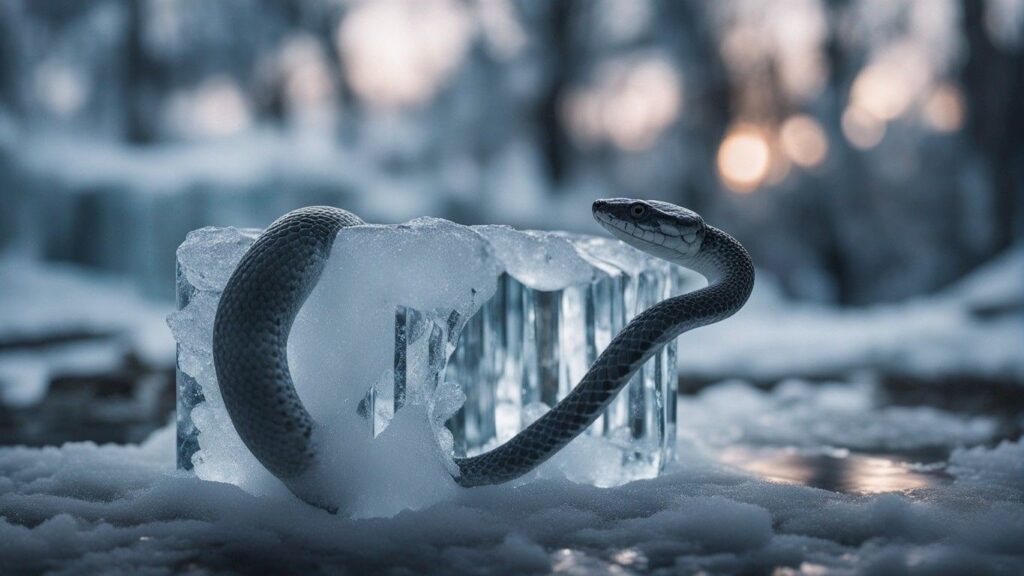
Final Thoughts
Snakes possess incredible adaptations that allow them to survive freezing temperatures. Through the use of antifreeze proteins, cryoprotectants, and strategic control of ice formation, snakes can endure being frozen without suffering irreparable damage.
This freezing tolerance, coupled with decreased metabolic rate and reduced locomotion, enables snakes to survive long periods of freezing conditions.
Understanding the physiological changes during freezing, as well as the thawing and recovery process, sheds light on the remarkable abilities of these cold-blooded creatures.
The potential applications in medicine make the study of snake freezing not only scientifically intriguing but also promising for advancements in various fields.


